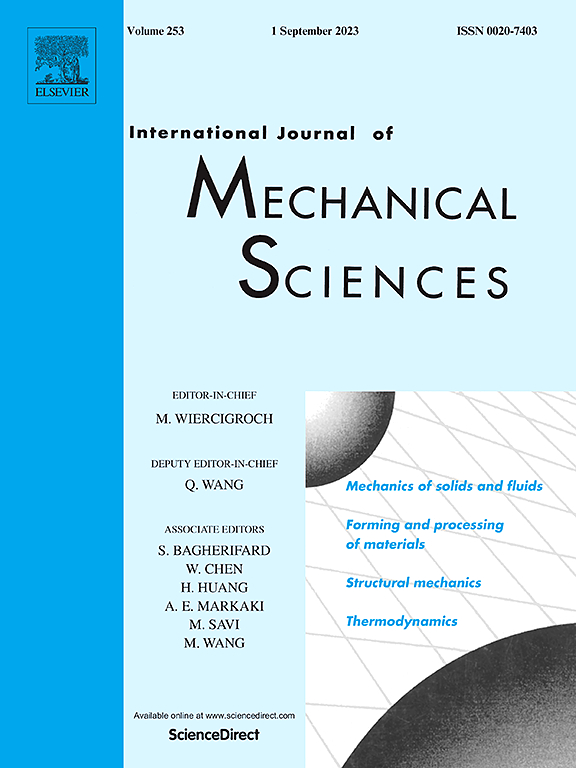Magnetic alignment of nanotubes for toughening fiber-reinforced composites
IF 9.4
1区 工程技术
Q1 ENGINEERING, MECHANICAL
International Journal of Mechanical Sciences
Pub Date : 2025-06-07
DOI:10.1016/j.ijmecsci.2025.110478
引用次数: 0
Abstract
This study investigates the multiscale toughening mechanisms of fiber-reinforced polymer (FRP) laminates enhanced with magnetically aligned Fe3O4-grafted carbon nanotubes (CNTs). CNTs were successfully oriented vertically in the fabrication of carbon fiber-reinforced polymer (CFRP), glass fiber-reinforced polymer (GFRP), and hybrid fiber-reinforced polymer (HFRP) laminates to improve their interlaminar fracture toughness. Double cantilever beam (DCB) tests revealed that the aligned CNTs significantly increased Mode I fracture toughness by 40.9 % in CFRP, 34.6 % in GFRP, and 76.3 % in HFRP at an optimal content of 0.3 wt. %. Scanning electron microscopy (SEM) analyses indicated enhanced fiber-matrix interfacial bonding, greater resin plastic deformation, and more tortuous crack paths due to the presence of CNTs. Molecular dynamics (MD) simulations further demonstrated that vertically aligned CNTs provide superior resistance to crack propagation through mechanisms such as nanotube bridging, anchoring, and energy dissipation. These findings offer new insights into the design of multiscale-toughened composite structures and highlight the effectiveness of magnetic alignment strategies in improving interlaminar performance.

纳米管增韧纤维增强复合材料的磁取向研究
本研究探讨了磁性排列fe3o4接枝碳纳米管(CNTs)增强纤维增强聚合物(FRP)层合板的多尺度增韧机制。在碳纤维增强聚合物(CFRP)、玻璃纤维增强聚合物(GFRP)和混杂纤维增强聚合物(HFRP)层压板的制备中,CNTs被成功地垂直定向,以提高其层间断裂韧性。双悬臂梁(DCB)试验表明,在最佳含量为0.3 wt. %的情况下,排列好的CNTs显著提高了CFRP的I型断裂韧性,分别提高了40.9%、34.6%和76.3%。扫描电镜(SEM)分析表明,由于CNTs的存在,纤维-基体界面结合增强,树脂塑性变形更大,裂纹路径更弯曲。分子动力学(MD)模拟进一步表明,垂直排列的碳纳米管通过纳米管桥接、锚定和能量耗散等机制提供了优越的抗裂纹扩展能力。这些发现为多尺度增韧复合材料结构的设计提供了新的见解,并突出了磁取向策略在改善层间性能方面的有效性。
本文章由计算机程序翻译,如有差异,请以英文原文为准。
求助全文
约1分钟内获得全文
求助全文
来源期刊

International Journal of Mechanical Sciences
工程技术-工程:机械
CiteScore
12.80
自引率
17.80%
发文量
769
审稿时长
19 days
期刊介绍:
The International Journal of Mechanical Sciences (IJMS) serves as a global platform for the publication and dissemination of original research that contributes to a deeper scientific understanding of the fundamental disciplines within mechanical, civil, and material engineering.
The primary focus of IJMS is to showcase innovative and ground-breaking work that utilizes analytical and computational modeling techniques, such as Finite Element Method (FEM), Boundary Element Method (BEM), and mesh-free methods, among others. These modeling methods are applied to diverse fields including rigid-body mechanics (e.g., dynamics, vibration, stability), structural mechanics, metal forming, advanced materials (e.g., metals, composites, cellular, smart) behavior and applications, impact mechanics, strain localization, and other nonlinear effects (e.g., large deflections, plasticity, fracture).
Additionally, IJMS covers the realms of fluid mechanics (both external and internal flows), tribology, thermodynamics, and materials processing. These subjects collectively form the core of the journal's content.
In summary, IJMS provides a prestigious platform for researchers to present their original contributions, shedding light on analytical and computational modeling methods in various areas of mechanical engineering, as well as exploring the behavior and application of advanced materials, fluid mechanics, thermodynamics, and materials processing.
 求助内容:
求助内容: 应助结果提醒方式:
应助结果提醒方式:


